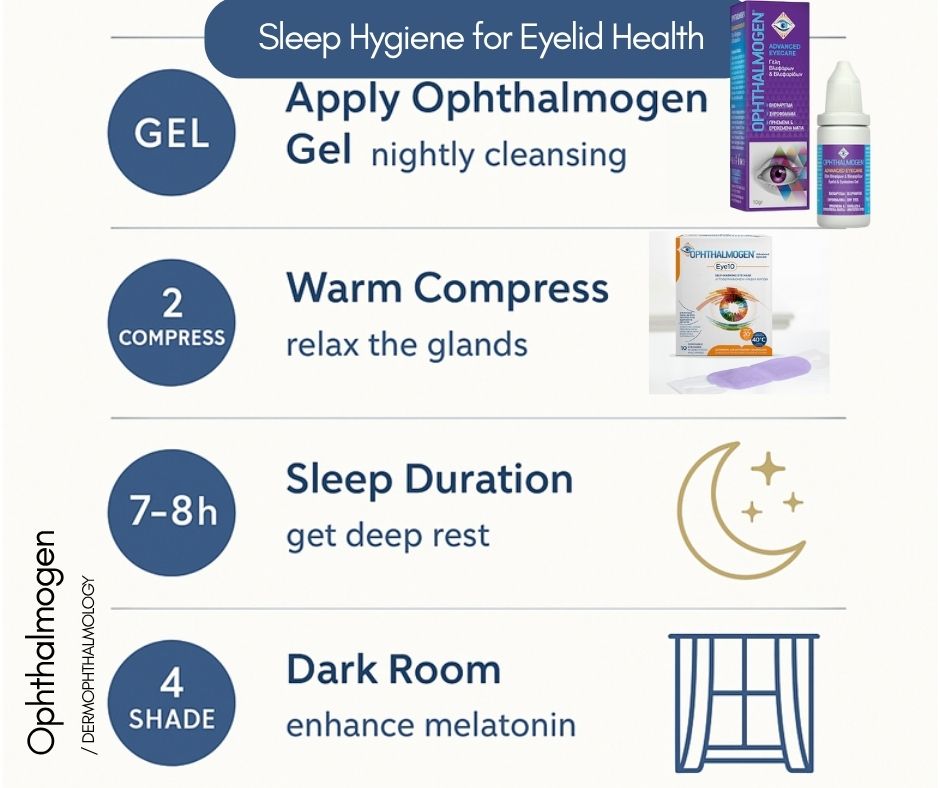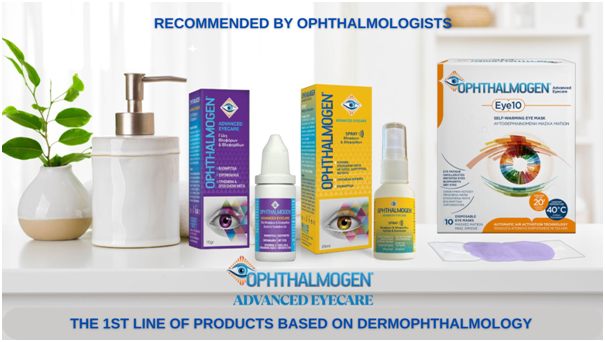
How Poor Sleep Fuels Eyelid Inflammation
Historical Perspective — Sleep as Medicine
Since antiquity, sleep has been regarded as a sacred act of healing.
Hippocrates described it as “the restoration of natural balance”, while Aristotle saw it as “the renewal of vital heat.”
At the Asclepia, sleep was ritual: patients slept in the sanctuary (engomisis) to receive healing visions.
Today we know that sleep is not a luxury, but a biological necessity – especially for eye and skin health.
What Is Sleep Hygiene?

Sleep hygiene refers to the set of behaviors that promote restorative sleep:
regular sleep schedule, limited screen exposure, cool and dark room, evening relaxation, and mindful routines.
But beyond rest, sleep is a core regulator of inflammation — particularly for the delicate eyelid glands and ocular surface.
The Biochemistry of Sleep and Inflammation
When sleep is insufficient (less than 6 hours/night), the body enters a stress–inflammation loop:
Increase Cortisol → activates IL-6 and TNF-α (key cytokines in eyelid inflammation)
Decrease Melatonin → loss of natural antioxidant and anti-inflammatory protection
Tear Film Instability → leads to dry eye, MGD, and chalazion recurrence
Melatonin is not just a “sleep hormone.” It functions as:
a powerful antioxidant,
an immunomodulator
and a tear film stabilizer, enhancing meibum secretion and lipid balance
Clinical Evidence

Study | Findings | Journal |
Alkozi et al., 2021 | Melatonin reduced IL-6 and MMP-9 on the ocular surface. | Sleep Medicine Reviews |
Martínez et al., 2019 | Poor sleepers showed higher MGD and chalazion prevalence. | Ocul Surf |
Kim et al., 2020 | Sleep deprivation caused tear film dysfunction and inflammation. | Invest. Ophthalmol. Vis. Sci. |
Chung et al., 2022 | Low melatonin correlated with elevated IL-17 and TNF-α. | Frontiers in Immunology |
Dermatology Review, 2023 | Sleep loss increases skin inflammation and reduces microcirculation. | J. Dermatol. Sci. |
The Nighttime Care Ritual
Dermophthalmology teaches that regeneration begins at night.
Your evening routine is not cosmetic — it is preventive physiology.
1.Ophthalmogen EYE10 → 40 °C × 20 min before sleep
Enhances microcirculation & lipid flow
2.Ophthalmogen Gel → 30 s gentle massage
Reduces IL-6, relaxes tension accumulated during the day
3.Ophthalmogen Spray (Tea Tree Oil) → before bedtime
Hydrates, balances pH, and restores eyelid barrier
Together, these steps improve nighttime eyelid temperature, regulate melatonin production, and help restore ocular surface equilibrium.

Sleep Through the Ages
1.Ancient Greece: Sleep was sacred — part of temple healing rituals.
2.Middle Ages: Sleep symbolized virtue and inner purity (“the sleep of the just”).
3.Modern era: It became a measure of productivity — and often, deprivation.
Today, science reclaims its original meaning:
Sleep is the body’s most natural medicine.
A Cross-Disciplinary Insight
Dermophthalmology bridges multiple scientific fields:
1.Neuroendocrinology: The HPA axis (Stress → Cortisol → Melatonin)
2.Dermatology: Skin inflammation, barrier recovery, and circadian repair
3.Ophthalmology: Tear film dynamics and meibomian gland homeostasis
4.Sleep Medicine & Psychology: Behavioral regulation and relaxation protocols
Conclusion
Poor sleep does not merely tire the eyes — it inflames them.
A mindful evening routine becomes both a medical prevention and a meditative ritual.
When we sleep well, the eyes don’t just rest — they regenerate.

Discover the full Ophthalmogen range at www.ophthalmogen.com and Dermophthalmology at www.Dermophthalmology.com
Give your eyes the care and beauty they deserve.






